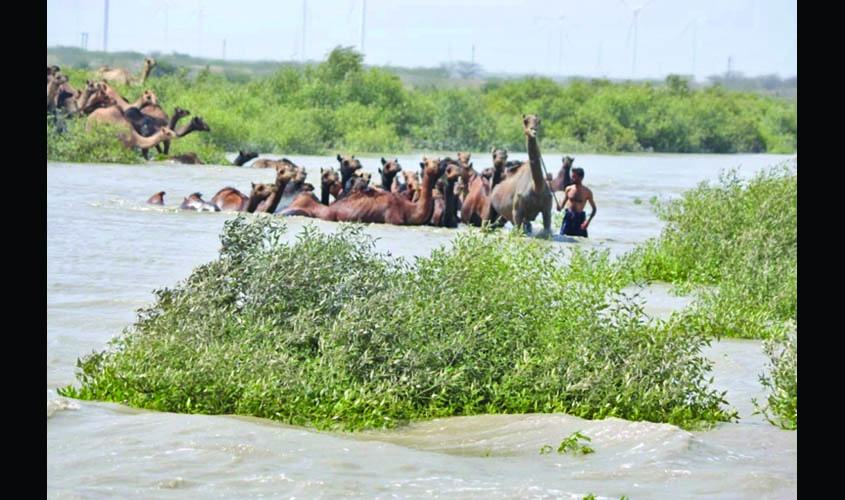BHUJ (GUJARAT): In the land of contrasts that Kutch is, winter is the lean feeding season for its unique breed of Kharai camels. These camels, unlike the kind most of us are familiar with, are typically dependent on the mangroves for their food, and during monsoons, they swim to the mangrove islands in hordes and stay there for days altogether.
The sight of swimming camels, as one can imagine, is spectacular, but faced with challenges such as rapid industrialisation in the coastal areas, and mangrove destruction, their population is dwindling, making it a threatened breed.
The Kharai camels are held with respect by the Rabari and Jat communities—the two tribes which own and handle the animals—and until a few years ago they did not even sell its milk or wool. For income, they depended on selling the male camels to traders who used them for transportation. With the advent of small commercial vehicles that can go deep into small towns and villages, camels are not used as much—one of the many reasons why these tribes are struggling socio-economically today.
The biggest reason, however, is restricted access to the mangrove islands, or Bets as they are called locally, and mangrove destruction. For eight months in a year, the Kharai camels are completely dependent on the mangrove islands, spending weeks together on these masses. They eat the saline plants and the mangrove species and drink rainwater accumulated in depressions on these islands. During winter, their handlers from the Jat community—Rabaris are typically the owners—graze them on the dry land.
The 2001 Bhuj earthquake saw massive devastation in Kutch, and as re-building efforts gained tempo, there began steady industrialisation along the coastline. There was a spurt of salt and cement factories.
Mahendra Bhanani of Sahjeevan, an NGO that has been working on the welfare of pastoralists and the Kharai camel for years now, said that industries typically block the natural creek in an area and create bunds that do not allow the natural tidal water to come in. This dries up the mangroves, and once that happens, it’s easier for heavy machinery to uproot them so that creation of saltpans is easier. Jetties do the same, blocking the water route of the camels permanently. G.A. Thivakaran, chief principal scientist and head of the Coastal and Marine Ecology Division of the Gujarat Institute of Desert Ecology, said that, in Kutch, mangroves are predominantly distributed in three coastal stretches—Jakhau-Kori, Mundra and Kandla-Surajbari.
“Ironically, in all these places industries are being aggressively developed. The general impact of coastal industries on mangroves is habitat fragmentation, closing feeding creek systems, shipping which cause gradual degradation, changes in water hydraulics due to dredging and other landform modifications,” he said.
Besides these, other factors such as obstruction of near-shore currents, increased sediment load in the water column, and physical destruction means that “coastal industries are generally detrimental to mangroves”.
The effect of such industrialisation on the Kharai camel has been grave. In Tunda vandh, a coastal village in Mundra, there was a time when almost every family owned Kharai camels. Dominated by the Rabari tribe, the residents remember instances when, during high tide, the sea water would flow into the boundary of their homes.
However, with two power plants coming up on either side, its access to the waters was cut off by a canal and conveyor belts built by the companies running the power plants. As a result, the handlers had to walk the camels a much longer distance around in order to reach the sea. Some breeders gave up, while others moved away from the village. So from around 2,500 camels about a decade back, less than 200 remain in the village today. According to a survey carried out by Sahjeevan, Kutch had 2,200 Kharai camels five years ago. In 2018, the number dwindled to 1,800. Gujarat, as a whole, has about 4,500 Kharai camels left. The immediate question looming over the pastoral communities and their camels is of sustenance and for this, organisations like Sahjeevan have been lobbying hard at different levels. — IANS
(In arrangement with Mongabay.com, a source for environmental news reporting and analysis. The views expressed in the article are those of Mongabay.com. Feedback: gopi@mongabay.com)

